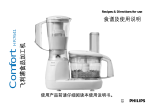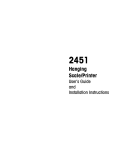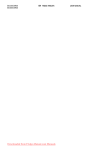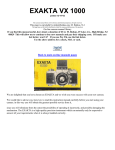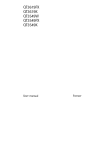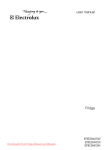Download AEG Electrolux S86348KG1 User manual
Transcript
S86348KG1 S86340KG1 User manual Fridge-Freezer 2 Contents Thank you for choosing one of our high-quality products. To ensure optimal and regular performance of your appliance please read this instruction manual carefully. It will enable you to navigate all processes perfectly and most efficiently. To refer to this manual any time you need to, we recommend you to keep it in a safe place. And please pass it to any future owner of the appliance. We wish you much joy with your new appliance. Contents Safety information Children and vulnerable people safety General safety Daily Use Care and cleaning Installation Service Control panel Display Switching on Switching off Switching off the fridge or freezer Switching on the fridge or freezer Temperature regulation Child Lock function Holiday function COOLMATIC function Quick Chill function FROSTMATIC function High temperature alarm First use Cleaning the interior Daily use Use of the fridge compartment Use of the freezer compartment Storage of frozen food Thawing Clean Air Control Filter Movable shelves Vegetable Drawer The Natura fresh zone Regulation of air humidity Positioning the door shelves Removal of freezing baskets from the freezer 3 3 3 4 4 4 5 5 6 6 6 6 7 7 7 7 8 8 9 9 10 10 10 10 11 11 11 11 12 12 13 13 13 Helpful hints and tips Hints for energy saving Hints for fresh food refrigeration Hints for refrigeration Hints for temperature inside the fridge 14 14 14 14 15 Hints for freezing 16 Hints for storage of frozen food 16 Care and cleaning 16 Periodic cleaning 16 Replacing the Clean Air Control filter 17 Cleaning the ventilation grille 17 Defrosting the refrigerator 18 Defrosting of the freezer 18 Periods of non-operation 18 What to do if… 18 Replacing the lamp 20 Closing the door 21 Technical data 21 Installation 21 Positioning 21 Location 22 Electrical connection 22 Removing the transport support 22 Removing the shelf holders 23 Rear spacers 23 Fitting the door handles 23 Levelling 24 Installation of the Clean Air Control filter 24 Door reversibility 25 Environmental concerns 25 14 Subject to change without notice Safety information 3 Safety information In the interest of your safety and to ensure the correct use, before installing and first using the appliance, read this user manual carefully, including its hints and warnings. To avoid unnecessary mistakes and accidents, it is important to ensure that all people using the appliance are thoroughly familiar with its operation and safety features. Save these in‐ structions and make sure that they remain with the appliance if it is moved or sold, so that everyone using it through its life will be properly informed on appliance use and safety. For the safety of life and property keep the precautions of these user's instructions as the manufacturer is not responsible for damages caused by omission. Children and vulnerable people safety • This appliance is not intended for use by persons (including children) with reduced physical, sensory or mental capabilities, or lack of experience and knowledge, unless they have been given supervision or instruction concerning use of the appliance by a person responsible for their safety. Children should be supervised to ensure that they do not play with the appliance. • Keep all packaging well away from children. There is risk of suffocation. • If you are discarding the appliance pull the plug out of the socket, cut the connection cable (as close to the appliance as you can) and remove the door to prevent playing children to suffer electric shock or to close themselves into it. • If this appliance featuring magnetic door seals is to replace an older appliance having a spring lock (latch) on the door or lid, be sure to make that spring lock unusable before you discard the old appliance. This will prevent it from becoming a death trap for a child. General safety CAUTION! Keep ventilation openings clear of obstruction. • The appliance is intended for keeping foodstuff and/or beverages in a normal household as explained in this instruction booklet. • Do not use a mechanical device or any artificial means to speed up the thawing process. • Do not use other electrical appliances (such as ice cream makers) inside of refrigerating appliances, unless they are approved for this purpose by the manufacturer. • Do not damage the refrigerant circuit. • The refrigerant isobutane (R600a) is contained within the refrigerant circuit of the ap‐ pliance, a natural gas with a high level of environmental compatibility, which is never‐ theless flammable. During transportation and installation of the appliance, be certain that none of the components of the refrigerant circuit become damaged. If the refrigerant circuit should become damaged: – avoid open flames and sources of ignition – thoroughly ventilate the room in which the appliance is situated • It is dangerous to alter the specifications or modify this product in any way. Any damage to the cord may cause a short-circuit, fire and/or electric shock. 4 Safety information WARNING! Any electrical component (power cord, plug, compressor) must be replaced by a certified service agent or qualified service personnel. 1. Power cord must not be lengthened. 2. Make sure that the power plug is not squashed or damaged by the back of the appliance. A squashed or damaged power plug may overheat and cause a fire. 3. Make sure that you can come to the mains plug of the appliance. 4. Do not pull the mains cable. 5. If the power plug socket is loose, do not insert the power plug. There is a risk of electric shock or fire. 6. You must not operate the appliance without the lamp cover1) of interior lighting. • This appliance is heavy. Care should be taken when moving it. • Do not remove nor touch items from the freezer compartment if your hands are damp/ wet, as this could cause skin abrasions or frost/freezer burns. • Avoid prolonged exposure of the appliance to direct sunlight. Daily Use • • • • • Do not put hot pot on the plastic parts in the appliance. Do not store flammable gas and liquid in the appliance, because they may explode. Do not place food products directly against the air outlet on the rear wall.2) Frozen food must not be re-frozen once it has been thawed out. Store pre-packed frozen food in accordance with the frozen food manufacturer's in‐ structions. • Appliance's manufacturers storage recommendations should be strictly adhered to. Refer to relevant instructions. • Do not place carbonated or fizzy drinks in the freezer compartment as it creates pressure on the container, which may cause it to explode, resulting in damage to the appliance. • Ice lollies can cause frost burns if consumed straight from the appliance. Care and cleaning • Before maintenance, switch off the appliance and disconnect the mains plug from the mains socket. • Do not clean the appliance with metal objects. • Do not use sharp objects to remove frost from the appliance. Use a plastic scraper. • Regularly examine the drain in the refrigerator for defrosted water. If necessary, clean the drain. If the drain is blocked, water will collect in the bottom of the appliance. • Never use a hair drier or other heating appliances to speed up defrosting. Excessive heat may damage the plastic interior, and humidity could enter the electric system making it live. Installation For electrical connection carefully follow the instructions given in specific paragraphs. 1) If the lamp cover is foreseen 2) If the appliance is Frost Free Control panel 5 • Unpack the appliance and check if there are damages on it. Do not connect the appliance if it is damaged. Report possible damages immediately to the place you bought it. In that case retain packing. • It is advisable to wait at least four hours before connecting the appliance to allow the oil to flow back in the compressor. • Adequate air circulation should be around the appliance, lacking this leads to overheat‐ ing. To achieve sufficient ventilation follow the instructions relevant to installation. • Wherever possible the back of the product should be against a wall to avoid touching or catching warm parts (compressor, condenser) to prevent possible burn. • The appliance must not be located close to radiators or cookers. • Make sure that the mains plug is accessible after the installation of the appliance. • Connect to potable water supply only.3) Service • Any electrical work required to do the servicing of the appliance should be carried out by a qualified electrician or competent person. • This product must be serviced by an authorized Service Centre, and only genuine spare parts must be used. Environment Protection This appliance does not contain gasses which could damage the ozone layer, in either its refrigerant circuit or insulation materials. The appliance shall not be discarded together with the urban refuse and rubbish. The insulation foam contains flammable gases: the appliance shall be disposed according to the applicable regulations to obtain from your local authorities. Avoid damaging the cooling unit, especially at the rear near the heat exchanger. The materials used on this appliance marked by the symbol are recyclable. Control panel 1 Fridge temperature colder button 2 Fridge temperature warmer button 3 ON/OFF button OK button 4 Freezer temperature warmer button 5 Display 3) If a water connection is foreseen 6 Control panel 6 Freezer temperature colder button 7 Mode button Display 1 2 3 4 5 6 7 8 9 Fridge temperature indicator Holiday function Fridge Off Freezer Off Freezer temperature indicator Alarm indicator FROSTMATIC function COOLMATIC function Child Lock function Switching on To switch on the appliance do these steps: 1. Connect the mains plug to the power socket. 2. Press the ON/OFF button if the display is off. 3. The alarm buzzer could operate after few seconds. To reset the alarm refer to "High temperature alarm". 4. The temperature indicators show the setted default temperature. To select a different set temperature refer to "Temperature regulation". Switching off To switch off the appliance do these steps: 1. Press the ON/OFF button for 5 seconds. 2. The display switches off. 3. To disconnect the appliance from the power disconnect the mains plug from the power socket. Switching off the fridge or freezer To switch off the fridge or freezer: 1. Press the Mode button until the corresponding icon appears. Control panel 7 The fridge or freezer Off indicator flashes. The fridge or freezer temperature indicator shows dashes. 2. Press the OK button to confirm. 3. The fridge or freezer Off indicator is shown. Switching on the fridge or freezer To switch on the fridge or freezer: 1. Press the fridge or freezer temperature regulator. Or: 1. Press the Mode button until the corresponding icon appears. The fridge or freezer Off indicator flashes. 2. Press the OK button to confirm. 3. The fridge or freezer Off indicator goes off. Temperature regulation The set temperature of the fridge and of the freezer may be adjusted by pressing the temperature regulators. Set default temperature: • +5°C for the fridge • -18°C for the freezer The temperature indicators show the set temperature. The set temperature will be reached within 24 hours. After a power failure the set temperature remains stored. Child Lock function To lock the buttons from unintentional operation select the Child Lock function. To switch on the function: 1. Press the Mode button until the corresponding icon appears. 2. The Child Lock indicator flashes. 3. Press the OK button to confirm. The Child Lock indicator is shown. To switch off the function: 1. Press the Mode button until the Child Lock indicator flashes. 2. Press the OK button to confirm. 3. The Child Lock indicator goes off. Holiday function This function allows you to keep the refrigerator closed and empty during a long holiday period without the formation of a bad smell. The fridge compartment must be empty with holiday function on. To switch on the function: 1. Press the Mode button until the corresponding icon appears. The Holiday indicator flashes. 8 Control panel The fridge temperature indicator shows the set temperature. 2. Press the OK button to confirm. The Holiday indicator is shown. To switch off the function: 1. Press the Mode button until the Holiday indicator flashes. 2. Press the OK button to confirm. 3. The Holiday indicator goes off. The function switches off by selecting a different fridge set temperature. COOLMATIC function If you need to insert a large amount of warm food, for example after doing the grocery shopping, we suggest activating the COOLMATIC function to chill the products more rapidly and to avoid warming the other food which is already in the refrigerator. To switch on the function: 1. Press the Mode button until the corresponding icon appears. The COOLMATIC indicator flashes. The fridge temperature indicator shows the set temperature. 2. Press the OK button to confirm. The COOLMATIC indicator is shown. The COOLMATIC function shuts off automatically after approximately 6 hours. To switch off the function before its automatic end: 1. Press the Mode button until the COOLMATIC indicator flashes. 2. Press the OK button to confirm. 3. The COOLMATIC indicator goes off. The function switches off by selecting a different fridge set temperature. Quick Chill function The Quick Chill function provide rapid cooling of cans and bottles through cold airstream. Put the cans/bottles on the Quick Chill bottle holder and open the air lever (1) towards maxi‐ mum. To switch on the function: 1. Press the Mode button until the corresponding icon appears The COOLMATIC indicator flashes. Control panel 9 The fridge temperature indicator shows the set temperature. 2. Press the OK button to confirm. The COOLMATIC indicator is shown. When the cooling is finished return the air lever (1) towards minimum. To switch off the function: 1. Press the Mode button until the COOLMATIC indicator flashes. 2. Press the OK button to confirm. 3. The COOLMATIC indicator goes off. The Quick Chill function stops automatically after approximately 6 hours. The Quick Chill bottle holder can be removed if not used. FROSTMATIC function It is possible to place the fresh food to be frozen in all compartments except the lowest. To switch on the function: 1. Press the Mode button until the corresponding icon appears. The FROSTMATIC indicator flashes. The freezer temperature indicator shows symbol. 2. Press the OK button to confirm. The FROSTMATIC indicator is shown. An animation starts. This function stops automatically after 52 hours. To switch off the function before its automatic end: 1. Press the Mode button until the FROSTMATIC indicator flashes. 2. Press the OK button to confirm. 3. The FROSTMATIC indicator goes off. The function switches off by selecting a different freezer set temperature. High temperature alarm An increase in the temperature in the freezer compartment (for example due to an earlier power failure) is indicated by: • flashing the alarm and freezer temperature indicators • sounding of buzzer. To reset the alarm: 1. Press any button. 2. The buzzer switches off. 3. The freezer temperature indicator shows the highest temperature reached for a few seconds. Then show again the set temperature. 4. The alarm indicator continue to flash until the normal conditions are restored. When the alarm has returned the alarm indicator goes off. 10 First use First use Cleaning the interior Before using the appliance for the first time, wash the interior and all internal accessories with lukewarm water and some neutral soap so as to remove the typical smell of a brandnew product, then dry thoroughly. Do not use detergents or abrasive powders, as these will damage the finish. Check that the drain hose at the rear of the cabinet discharges into the drip tray. Daily use Use of the fridge compartment The temperature of this compartment may be regulated between +3°C and +8°C. During normal functioning the indicator shows the set temperature inside the fridge. A medium setting is generally the most suitable. The exact setting should be chosen keeping in mind that the temperature inside the ap‐ pliance depends on: • room temperature • how often the door is opened • the quantity of food stored • the location of the appliance. If the ambient temperature is high or the appliance is fully loaded, and the appliance is set to the lowest temperatures, it may run continuously causing frost to form on the rear wall. In this case the Temperature regulator must be set to a warmer temperature to allow automatic defrosting and therefore reduced energy consumption. Daily use 11 Use of the freezer compartment The symbol means that the freezer is suitable for freezing fresh food and for long term storage. The temperature may be regulated between -15°C and -24°C. We suggest setting the temperature to -18°C, which is optimal for energy consumption and frozen food storage. Difference between setting temperature and actual temperature is normal. Especially when: • a new setting has recently been selected • the door has been open for a long time • warm food has been placed in the compartment. Difference until 5°C inside the compartment are quite normal. During operation the temperature indicator shows setting value. Storage of frozen food When first starting-up or after a period out of use, before putting the products in the compartment let the appliance run at least 2 hours. The freezer baskets ensure that it is quick and easy to find the food package you want. If large quantities of food are to be stored, remove all drawers except for the bottom basket which needs to be in place to provide good air circulation. On all shelves except for the top shelf it is possible to place food that protrude until load limit stated on the side of the middle section In the event of accidental defrosting, for example due to a power failure, if the power has been off for longer that the value shown in the technical characteristics chart under "rising time", the defrosted food must be consumed quickly or cooked immediately and then refrozen (after cooling). Thawing Deep-frozen or frozen food, prior to being used, can be thawed in the refrigerator com‐ partment or at room temperature, depending on the time available for this operation. Small pieces may even be cooked still frozen, directly from the freezer: in this case, cooking will take longer. Clean Air Control Filter Your appliance is equipped with a carbon filter behind the air lever flap. The filter purifies the air from unwanted odours in the fridge compartment preserving food quality. On delivery the filter is in a plastic bag. Refer to "Installation of the Clean Air Control filter" for instructions. Make sure that the air lever flap is closed to obtain proper function. 12 Daily use Movable shelves The walls of the refrigerator are equipped with a series of runners so that the shelves can be posi‐ tioned as desired. Some shelves must be lifted up by the rear edge to enable them to be removed. Do not move the glass shelf above the vegetable drawer to ensure correct air circulation. Vegetable Drawer The drawer is suitable for storing fruit and vegetables. Some models have a separator inside the drawer that can be placed in different positions to allow for the subdivision best suited to personal needs. All parts inside the drawer can be removed for cleaning purposes. Daily use 13 The Natura fresh zone The temperature in the Natura fresh zone is con‐ stantly just above 0°C. Adjustment by the user is not necessary. The Natura fresh zone contains two drawers. The lower drawer with a higher humidity of the air, is suited for keeping berries, fruits and vege‐ tables. The upper drawer is suited for meat, fish and poultry. Foodstuffs not suitable to keep in the Natura fresh zone: • Cold sensitive fruits like bananas, papaya, pas‐ sion fruits, avocado and citrus fruits. • Cold sensitive vegetables like pimiento, cucum‐ ber courgette, aubergine potatoes and toma‐ toes. Fruit and vegetables not yet mellow like pears. Pack all foodstuffs before keeping in the Natura fresh zone. In this way aroma, moisture and colour is kept for a longer time. Suitable packing materials: • Polyethylene airtight bags and wraps • Plastic containers with lids • Aluminium foil Regulation of air humidity The two drawers are fitted with adjustable air slots. The opening of the air slots can be adjusted with sliders, to regulate the humidity inside the drawers. • With the air slots open, the stronger air circulation results in a lower air moisture in the drawer. • A closed air slots keeps the natural air moisture for longer. Positioning the door shelves To permit storage of food packages of various sizes, the door shelves can be placed at different heights. 14 Helpful hints and tips Gradually pull the shelf in the direction of the ar‐ rows until it comes free, then reposition as re‐ quired. Do not move the lower door shelf to ensure cor‐ rect air circulation. Removal of freezing baskets from the freezer The freezing baskets have a limit stop to prevent their accidental removal or falling out. At the time of its removal from the freezer, pull the basket towards yourself and, upon reaching the end point, remove the basket by tilting its front up‐ wards. At the time of putting it back, slightly lift the front of the basket to insert it into the freezer. Once you are over the end points, push the baskets back in their position. Helpful hints and tips Hints for energy saving • Do not open the door frequently or leave it open longer than absolutely necessary. • If the ambient temperature is high and the Temperature Regulator is set to low tem‐ perature and the appliance is fully loaded, the compressor may run continuously, causing frost or ice on the evaporator. If this happens, set the Temperature Regulator toward warmer settings to allow automatic defrosting and so a saving in electricity consumption. Hints for fresh food refrigeration To obtain the best performance: • do not store warm food or evaporating liquids in the refrigerator • do cover or wrap the food, particularly if it has a strong flavour • position food so that air can circulate freely around it Hints for refrigeration Useful hints: Helpful hints and tips 15 Meat (all types) : wrap in polythene bags and place on the glass shelf above the vegetable drawer. For safety, store in this way only one or two days at the most. Cooked foods, cold dishes, etc..: these should be covered and may be placed on any shelf. Fruit and vegetables: these should be thoroughly cleaned and placed in the special drawer(s) provided. Butter and cheese: these should be placed in special airtight containers or wrapped in aluminium foil or polythene bags to exclude as much air as possible. Milk bottles: these should have a cap and should be stored in the bottle rack on the door. Bananas, potatoes, onions and garlic, if not packed, must not be kept in the refrigerator. Hints for temperature inside the fridge A suitable temperature inside the fridge is approx. +5° C. When the temperature regulator is set to +5°C this represents the mean temperature in the fridge. It is normal with higher temperature in the top of the fridge. It is also normal with lower temperature in the lower part. If the temperature regulator is set to a cold temperature, the ambient temperature is high or if the fridge is fully loaded the compressor will run for a longer time. It too cold, change to a higher temperature setting. Do not place food against or close to the temper‐ ature sensor. This can result in too cold tempera‐ tures. If you want to check the temperature of food stored in the refrigerator, place a glass of water centrally in the cabinet, and put a proper ther‐ mometer with an accuracy of +/– 1 °C into it. After 6 hours the temperature can be monitored. The measuring shall be performed under steady-sta‐ ted conditions (without changing the load). 16 Care and cleaning Hints for freezing To help you make the most of the freezing process, here are some important hints: • the maximum quantity of food which can be frozen in 24 hrs. is shown on the rating plate; • the freezing process takes 24 hours. No further food to be frozen should be added during this period; • only freeze top quality, fresh and thoroughly cleaned, foodstuffs; • prepare food in small portions to enable it to be rapidly and completely frozen and to make it possible subsequently to thaw only the quantity required; • wrap up the food in aluminium foil or polythene and make sure that the packages are airtight; • do not allow fresh, unfrozen food to touch food which is already frozen, thus avoiding a rise in temperature of the latter; • lean foods store better and longer than fatty ones; salt reduces the storage life of food; • water ices, if consumed immediately after removal from the freezer compartment, can possibly cause the skin to be freeze burnt; • it is advisable to show the freezing in date on each individual pack to enable you to keep tab of the storage time. Hints for storage of frozen food To obtain the best performance from this appliance, you should: • make sure that the commercially frozen foodstuffs were adequately stored by the re‐ tailer; • be sure that frozen foodstuffs are transferred from the foodstore to the freezer in the shortest possible time; • not open the door frequently or leave it open longer than absolutely necessary. • Once defrosted, food deteriorates rapidly and cannot be refrozen. • Do not exceed the storage period indicated by the food manufacturer. Care and cleaning CAUTION! Unplug the appliance before carrying out any maintenance operation. This appliance contains hydrocarbons in its cooling unit; maintenance and recharging must therefore only be carried out by authorized technicians. Periodic cleaning The equipment has to be cleaned regularly: • clean the inside and accessories with lukewarm water and some neutral soap. • regularly check the door seals and wipe clean to ensure they are clean and free from debris. • rinse and dry thoroughly. Do not pull, move or damage any pipes and/or cables inside the cabinet. Never use detergents, abrasive powders, highly perfumed cleaning products or wax polishes to clean the interior as this will damage the surface and leave a strong odour. Care and cleaning 17 Clean the condenser (black grill) and the compressor at the back of the appliance with a brush or a vacuum cleaner. This operation will improve the performance of the appliance and save energy consumption. Take care of not to damage the cooling system. When moving the cabinet, lift it by the front edge to avoid scratching the floor. Many proprietary kitchen surface cleaners contain chemicals that can attack/damage the plastics used in this appliance. For this reason use a soft cloth rinsed in warm water and neutral soap emulsion for cleaning external surfaces. Do not use detergents or abrasive paste as these will damage the paint, or stainless steel anti finger print coating. After cleaning, reconnect the equipment to the mains supply. Replacing the Clean Air Control filter To get the best performance replace the Clean Air Control filter once every year. New active filters can be purchased from your local dealer. Refer to "Installation of the Clean Air Control filter" for instructions. Cleaning the ventilation grille The ventilation grille can be removed for washing. Make sure the door is open and then: 1. Loosen the upper edge of the grille by pulling outward/downward. 2. Pull the grille straight out to completely remove it. 3. Vacuum clean under the cabinet. 18 What to do if… Defrosting the refrigerator Frost is automatically eliminated from the evap‐ orator of the refrigerator compartment every time the motor compressor stops, during normal use. The defrost water drains out through a drain hole into a special container at the back of the appli‐ ance, over the motor compressor, where it evap‐ orates. It is important to periodically clean the defrost water drain hole to prevent the water overflowing and dripping onto the food inside. It is located behind the Natura fresh drawers in the refrigera‐ tor compartment. Defrosting of the freezer The freezer compartment of this model, on the other hand, is a "no frost" type. This means that there is no buildup of frost when it is in operation, neither on the internal walls nor on the foods. The absence of frost is due to the continuous circulation of cold air inside the compartment, driven by an automatically controlled fan. Periods of non-operation When the appliance is not in use for long periods, take the following precautions: 1. disconnect the appliance from electricity supply 2. remove all food 3. clean the appliance and all accessories 4. leave the door/doors open to prevent unpleasant smells. If the cabinet will be kept on, ask somebody to check it once in a while to prevent the food inside from spoiling in case of a power failure. What to do if… During operation of the appliance some smaller but annoying trouble can often occur, which does not require calling a technician out. In the following chart information is given about them to avoid unnecessary charges on service. The operation of the appliance goes with certain sounds (compressor and circulating sound). This not means a trouble, but a normal operation. The appliance operates discontinuously, so the stopping of compressor does not mean being no current. That is why you must not touch the electrical parts of the appliance before breaking the circuit. What to do if… Problem The appliance is noisy. 19 Possible cause Solution The appliance is not supported properly. Check if the appliance stands sta‐ ble (all feet and wheels should be on the floor). Refer to "Levelling". The cushion spacers located be‐ Put them back in place again. tween the back of the cabinet and the pipes come loose. The buzzer sounds. The Alarm icon flashing. The temperature in the freezer is Refer to "High Temperature too high. Alarm" upper or lower square An error has occurred in meas‐ is shown in the tempera‐ uring the temperature. ture display. Call your service representative (the cooling system will continue to keep food products cold, but temperature adjustment will not be possible). The compressor runs continuously. The Temperature regulator may be set incorrectly. Set a warmer temperature. The door is not closed correctly. Refer to "Closing the door". The door has been opened too frequently. Do not keep the door open longer than necessary. The food temperature is too high. Let the food temperature de‐ crease to room temperature be‐ fore storage. The room temperature is too high. Decrease the room temperature. The water outlet is clogged. Clean the water outlet. Food prevent that water flows into the water collector. Make sure that food do not touch the rear plate. Water flows inside the refrigerator. Water flows on the ground. The melting water outlet does Attach the melting water outlet not flow in the evaporative tray to the evaporative tray. above the compressor. There is too much frost and ice. The door is not closed correctly. Refer to "Closing the door". The door gasket is deformed or dirty. Refer to "Closing the door". The temperature in the appliance is too cold. The Temperature regulator may be set incorrectly. Set a warmer temperature. Refer to "Hints for temperature inside the fridge. The temperature in the appliance is too warm. The Temperature regulator may be set incorrectly. Set a colder temperature. The door is not closed correctly. Refer to "Closing the door". 20 What to do if… Problem Possible cause The food temperature is too high. Solution Let the food temperature de‐ crease to room temperature be‐ fore storage. There is no cold air circulation in Make sure that there is space be‐ The temperature in the tween food to allow air circula‐ refrigeration is too warm. the appliance. tion. The temperature in the freezer is too warm. The appliance does not operate. Large quantities of food to be cooled were put in at the same time. Insert smaller quantities of food to be cooled at the same time. Food is too near to each other. Store food so that there is cold air circulation. Large quantities of food to be frozen were put in at the same time. Insert smaller quantities of food to be frozen at the same time. The appliance is switched off. Switch on the appliance. The mains plug is not connected Connect the mains plug to the to the mains socket correctly. mains socket correctly. The appliance has no power. Connect another electrical appli‐ There is no voltage in the mains ance to the mains socket. Check socket. fuse. Contact a qualified electri‐ cian. The lamp does not work. The door has been open to long. Close the door. The lamp is defective. Refer to "Replacing the lamp". Door interferes with ven‐ The appliance is not levelled. tilation grill. Refer to "Levelling" Misaligned door Refer to "Levelling" The appliance is not levelled. As much as the advice does not lead to result, call the nearest brand-mark service. Replacing the lamp 1. Disconnect the mains plug from the power socket. Technical data 21 2. Remove the screw from the lamp cover. 3. Remove the lamp cover. 4. Replace the bulb (E14 socket) with one of the same power (the maximum power is shown on the lamp cover). 5. Install the lamp cover. 6. Tighten the screw to the lamp cover. 7. Connect the mains plug to the power socket. Closing the door 1. Clean the door gaskets. 2. If necessary, adjust the door. Refer to "Installation". 3. If necessary, replace the defective door gaskets. Contact the Service Center. Technical data S86340KG1 S86348KG1 Dimension Rising Time Height 2000 mm 2000 mm Width 595 mm 595 mm Depth 623 mm 623 mm 10 h 10 h The technical information are situated in the rating plate on the internal left side of the appliance and in the energy label. Installation WARNING! Read the "Safety Information" carefully for your safety and correct operation of the ap‐ pliance before installing the appliance. Positioning Install this appliance at a location where the ambient temperature corresponds to the climate class indicated on the rating plate of the appliance: 22 Installation Climate class Ambient temperature SN +10°C to + 32°C N +16°C to + 32°C ST +16°C to + 38°C T +16°C to + 43°C Location To ensure best performance, if the appliance is positioned below an overhanging wall unit, the minimum distance between the top of the cabinet and the wall unit must be at least 40 mm . Ideally, however, the appliance should not be positioned below overhanging wall units. If the cabinet is placed in a corner and the side with the hinges facing the wall, the distance between the wall and the cabinet must be at least 360 mm to allow the door to open enough so that the equipment can be removed. The ventilation space can be: • directly above the appliance • behind and above the top cupboard. In this case, the space behind the top cupboard must be at least 50 mm deep. Electrical connection Before plugging in, ensure that the voltage and frequency shown on the rating plate cor‐ respond to your domestic power supply. The appliance must be earthed. The power supply cable plug is provided with a contact for this purpose. If the domestic power supply socket is not earthed, connect the appliance to a separate earth in compliance with current regulations, consulting a qualified electrician. The manufacturer declines all responsibility if the above safety precautions are not ob‐ served. This appliance complies with the E.E.C. Directives. Removing the transport support Your appliance is equipped with transport support to secure the door during transportation. To remove them do these steps: Installation 1. Open the door. 2. Remove the transport support from the door sides. 3. Remove the transport support from the lower hinge (some models). Some models are fitted with a silencing pad under the cabinet. Do not remove this pad. Removing the shelf holders Your appliance is equipped with shelf retainers that make it possible to secure the shelves during transportation. To remove them proceed as follows: 1. Move the shelf holders in the direction of the arrow (A). 2. Raise the shelf from the rear and push it for‐ ward until it is freed (B). 3. Remove the retainers (C). Rear spacers Install the spacers provided within the accessory bag as shown in the figure. Install the spacers on the back side of the panel. Fitting the door handles The handles are supplied as a kit at delivery. 23 24 Installation 1. Screw the top handle bracket to the han‐ dle rod. 2. Fit the bottom handle bracket on the low‐ er right-hand side of the door. 3. Fit the top handle bracket on the top right-hand side of the door. 4. Screw the handle rod to the bottom han‐ dle bracket. Do not use excessive force and overtighten the screws (max. 2 Nm) as you may damage the door handles. Levelling When placing the appliance ensure that it stands level. If necessary adjust the feet using the ad‐ justment spanner supplied. Door alignment is dependent on proper levelling. Installation of the Clean Air Control filter The Clean Air Control filter is an active carbon filter which absorbs bad odours maintain the best flavour and aroma for all foodstuffs without risk of odour cross contamination. On delivery the carbon filter is in a plastic bag to preserve performance. 1. Open the air lever flap. 2. Take the filter out of the plastic bag. Environmental concerns 25 3. Insert the filter in the slot found in the back of the air lever flap. 4. Close the air lever flap. The filter should be handled carefully so frag‐ ments do not loosen from the surface. Make sure that the air lever flap is closed to obtain proper function. Door reversibility The door reversibility is not possible. Environmental concerns The symbol on the product or on its packaging indicates that this product may not be treated as household waste. Instead it should be taken to the appropriate collection point for the recycling of electrical and electronic equipment. By ensuring this product is disposed of correctly, you will help prevent potential negative consequences for the environment and human health, which could otherwise be caused by inappropriate waste handling of this product. For more detailed information about recycling of this product, please contact your local council, your household waste disposal service or the shop where you purchased the product. 26 27 298376868-00 30122009 www.electrolux.com




























